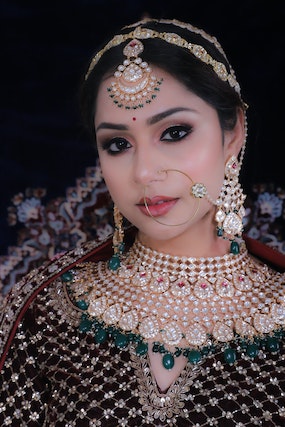Indian jewelry has a longstanding history that’s deeply intertwined with the country’s culture, traditions, and artistry. Adorned by both men and women, Indian jewelry is more than just ornamental embellishments; it’s a reflection of India’s rich heritage and diverse aesthetics. In this exploration of Indian jewelry, we’ll delve into the significance, types, and craftsmanship that make these pieces not only visually stunning but also deeply meaningful.
A Tapestry of Tradition and Culture
Indian jewelry is a testament to the country’s cultural diversity and history. Each region in India boasts its unique style and motifs, resulting in a stunning array of jewelry designs that carry stories of bygone eras. From the intricate filigree work of Rajasthan to the temple jewelry of South India, every piece is a canvas showcasing the heritage of its origin.
Types of Indian Jewelry
- Polki and Kundan: These styles feature uncut diamonds (polki) and glass stones (kundan) set in intricate patterns, creating a dazzling and regal look. Originating in Rajasthan, they are often used in bridal and ceremonial jewelry.
- Temple Jewelry: Hailing from the southern states, temple jewelry is inspired by temple architecture and deities. It often includes intricate motifs of gods, goddesses, and sacred animals.
- Meenakari: This technique involves enameling colorful designs onto metal surfaces. Meenakari jewelry is known for its vibrant and detailed patterns, originating in the Mughal era.
- Jadau: An art that combines polki and kundan styles with engraved gold designs, jadau jewelry is celebrated for its intricate craftsmanship and historical significance.
- Beaded Jewelry: Various regions create beaded jewelry using materials like pearls, semi-precious stones, and even seeds. Each piece reflects local aesthetics and traditional practices.
Craftsmanship and Techniques
Indian jewelry is meticulously crafted by skilled artisans using techniques passed down through generations. These craftsmen invest hours, even days, to create a single piece, ensuring every detail is a testament to their dedication and expertise. Techniques like filigree, engraving, enameling, and stone setting contribute to the uniqueness of Indian jewelry.
Jewelry in Everyday Life
Indian jewelry isn’t limited to special occasions; it’s an integral part of daily life. Traditional pieces, passed down through generations, hold sentimental value and are often worn as expressions of cultural identity and familial connections.
Modern Adaptations and Global Influence
In recent times, Indian jewelry has transcended its cultural borders, captivating international audiences with its opulence and uniqueness. Designers are reimagining traditional pieces, infusing them with contemporary aesthetics, making them wearable for various occasions.



